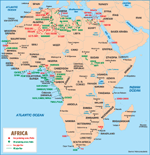Africa: Libya
Aug. 2001 Vol. 222 No. 8 International Outlook AFRICA Cyril Widdershoven, Consultant, Sittard, Netherlands (Libya, Tunisia, Uganda, Algeria, Sudan, Chad, Egypt, Morocco, Ma
AFRICACyril Widdershoven, Consultant, Sittard, Netherlands (Libya, Tunisia, Uganda, Algeria, Sudan, Chad, Egypt, Morocco, Mauritania and Senegal sections); Geoff H.H. King, Managing Editor, energyeuroafrica.com (Libya, Tunisia and Uganda sections); Mark Pabst, Senior Editor, Oil and Gas North Africa magazine, Cairo (Algeria, Sudan and Chad sections); David Fuller, Senior Researcher, Oil and Gas North Africa magazine, Cairo (Egypt, Morocco, Mauritania and Senegal sections); and World Oil Staff Libya
Libya’s petroleum sector is a renewed E&P hotspot, although the threat of sanctions from the U.S.-originated, Iran-Libya Sanctions Act (ILSA) still constrains investment opportunities. The country is actively pursuing investors, but ruler Muammar Ghadaffi’s regime remains a deterrent. A reshuffling of the government, including a shutdown of the Oil Ministry, has resulted in the shelving of a new petroleum law, indefinitely. Restructuring of the energy sector, including the new law’s implementation, had been demanded by international operators for years. Former Oil Minister Abdullah Salem Al Badri was appointed chairman of the National Oil Company (NOC) after the ministry was closed. Exploration. Lundin Oil’s International Petroleum Libya Ltd. (IPLL) subsidiary completed a 255-mi, 2-D seismic shoot on Area NC177, onshore in the southern Sirte basin, with detailed interpretation of the data underway. The firm also resumed exploration drilling in the area. IPLL plugged two wildcats – D1-NC177 and E1-NC177 – that it drilled on Area NC177. Repsol-YPF (operator, 32%) and partners TotalFinaElf (24%), OMV (24%) and Saga Petroleum (20%) have struck three oil discoveries on Block NC186 in the Murzuk basin. The first wildcat, A-1, encountered an oil column in December that flowed 2,500 bpd of 41°API crude. The second discovery, B-1, struck a significant oil column in the Mamouniyat formation and flowed 1,300 bpd of 40°API oil. Finally, in May 2001, the A-2 well tested 2,670 bpd of 41°API crude from the middle Ordovician sandstone of the Hawaz formation. Libya’s National Oil Agency reported a large gas find northwest of Assoumoud. Potential reserves are believed to be 474 Bcf of recoverable gas.
Drilling / development. Lundin Oil awarded two contracts for development of En Naga North and West oil fields in Block NC-177. The firm also awarded a contract for supply of 59 mi (94.5 km) of 12-in. pipeline to link En Naga’s output with the Samah production facility. En Naga will produce in excess of 15,000 bopd from early 2001, which will increase to a peak rate of 24,000 bopd in Phase II. Work on Elephant field, which holds about 1.5 billion bbl of crude, has been delayed due to the Amerada Hess takeover of Lasmo UK, and ILSA restrictions TotalFinaElf commenced development work on structure B of Block 137, offshore Libya. The find was struck in 1975, in 205 ft (90 m) of water. Facilities will include a well platform connected to an FPSO. Development plans call for production start-up in early 2003, rising to 35,000 bopd. Production. Oil output averaged 1.41 million bpd last year, up 6.8% from 1999’s level. Through first-quarter 2001, crude production averaged 1.40 million bpd. Libya’s output capacity is estimated at 1.6 million bopd, but its OPEC quota is 1.296 million bopd. Germany’s Wintershall has sought permission from
Libya to drill in oil fields that formerly belonged to U.S. companies. The move has only added to the fight
between the U.S. and Europe over ILSA.
|
- Applying ultra-deep LWD resistivity technology successfully in a SAGD operation (May 2019)
- Adoption of wireless intelligent completions advances (May 2019)
- Majors double down as takeaway crunch eases (April 2019)
- What’s new in well logging and formation evaluation (April 2019)
- Qualification of a 20,000-psi subsea BOP: A collaborative approach (February 2019)
- ConocoPhillips’ Greg Leveille sees rapid trajectory of technical advancement continuing (February 2019)



